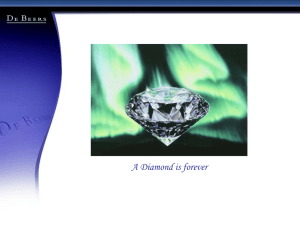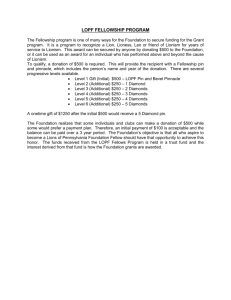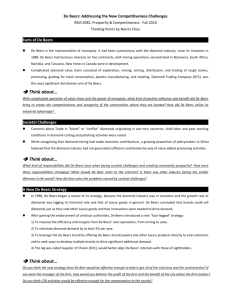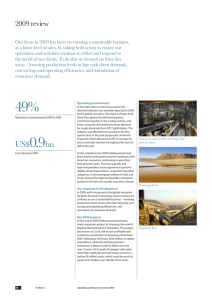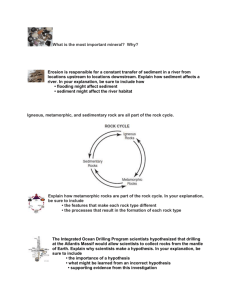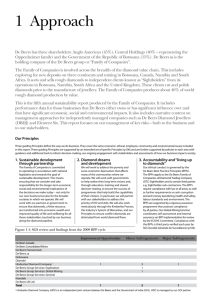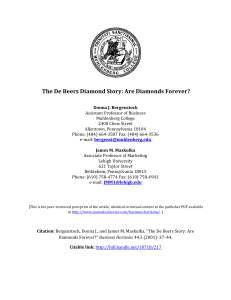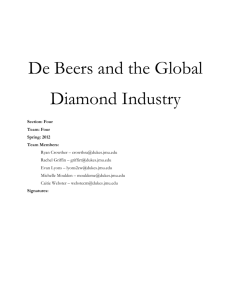Business Situation Framework - The Hopkins Graduate Student
advertisement
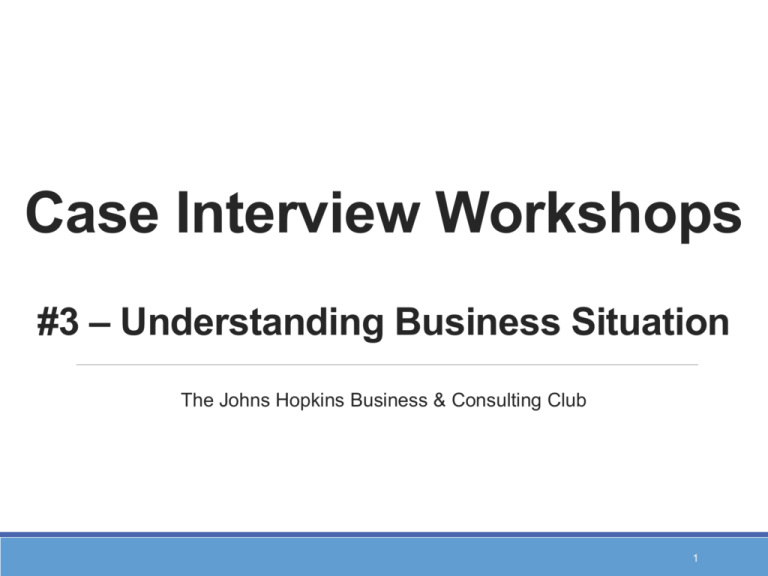
Case Interview Workshops #3 – Understanding Business Situation The Johns Hopkins Business & Consulting Club 1 Goals to achieve today 1. Understand the business situation framework 2. Do a business situation market entry case 2 Types of case interview question could vary a lot… 1. Growth: a. Top-line (revenue) growth b. Bottom-line (profitability) growth 2. Business Situations a. b. c. d. e. New products or services Market entry Competition Pricing and valuation Operations 3. Merger & Acquisitions 3 Business Situation Framework Customers Product Company Competition • Who? • Segment size and growth? • Preferences? – wants, price points, distribution • Advantages/disadvantages • Substitutes • Why is it useful? Does it match customer needs? • • • • What does client do well? Capabilities? Financials – profitability (R, C, market share) Brand reputation • Who? • Size? By market share, revenue, etc. • What do they do well? – best practices 4 The good news - the format is almost same for all cases! 1. Establishing Background: 1. Listening to the case 2. Understanding objectives 5 min 3. Clarifying questions 2. Structuring Approach: 1. Structuring in a MECE way 2. Hypothesizing 3-4 min 3. Prioritizing 3. Analysis 1. Quantitatively analyzing 15-20 min 2. Qualitatively analyzing 4. Recommendation 1-3 min *Interviews can also be interviewer-led or interviewee-led 5 Business Situation Case: Market Entry 6 Case Prompt De Beers, one of the leader diamond exploration companies in the world, is thinking about entering the retail business Should De Beers do so? Wharton 2008 Case Book 7 Establish Background: Ask clarifying questions De Beers, one of the leader diamond exploration companies in the world, is thinking about entering the retail business Should De Beers do so? 1. What is involved in diamond exploration business? 2. What is involved in diamond retail business? 3. What is client trying to achieve with this? Increased profit, market share, or revenue? Wharton 2008 Case Book 8 Establish Background: Ask clarifying questions De Beers, one of the leader diamond exploration companies in the world, is thinking about entering the retail business Should De Beers do so? 1. What is involved in diamond exploration business? 2. What is involved in diamond retail business? 3. What is client trying to achieve with this? Increased profit, market share, or revenue? It is crucial to understand De Beers’ value chain: exploration – extraction – distribution – polishing and finishing – jewelers – retail. De Beers is currently in exploration, extraction, and in distribution and would like to enter retail. They won’t, however, enter polishing or jewelling. Basically, De Beers wants to take advantage of their brand equity to sell finished diamonds. They would continue selling raw diamonds to polishers and they would then buy finished diamonds from jewelers. Wharton 2008 Case Book 9 Establish Background: Ask clarifying questions De Beers, one of the leader diamond exploration companies in the world, is thinking about entering the retail business Should De Beers do so? 1. What is involved in diamond exploration business? 2. What is involved in diamond retail business? 3. What is client trying to achieve with this? Increased profit, market share, or revenue? It is crucial to understand De Beers’ value chain: exploration – extraction – distribution – polishing and finishing – jewelers – retail. De Beers is currently in exploration, extraction, and in distribution and would like to enter retail. They won’t, however, enter polishing or jewelling. Basically, De Beers wants to take advantage of their brand equity to sell finished diamonds. They would continue selling raw diamonds to polishers and they would then buy finished diamonds from jewelers. Wharton 2008 Case Book 10 Structuring Your Approach What areas are important for this case? Customers Product Company Competition • Who? • Segment size and growth? • Preferences? – wants, price points, distribution • Advantages/disadvantages • Substitutes • Why is it useful? Does it match customer needs? • • • • What does client do well? Capabilities? Financials – profitability (R, C, market share) Brand reputation • Who? • Size? By market share, revenue, etc. • What do they do well? – best practices 11 Structuring Your Approach What areas are important for this case? Customers Product Company Competition • Who? • Segment size and growth? • Preferences? – wants, price points, distribution • Advantages/disadvantages • Substitutes • Why is it useful? Does it match customer needs? • • • • What does client do well? Capabilities? Financials – profitability (R, C, market share) Brand reputation • Who? • Size? By market share, revenue, etc. • What do they do well? – best practices Hypothesis: It is a good idea to enter the retail diamond business if it is profitable for De Beers and there are low barriers of entry. 12 Structuring Your Approach Is there an opportunity? Customers Competition 13 Structuring Your Approach Is there an opportunity? Customers Competition • Who buys diamonds? – wealthy/excess income • Why? – gifts or personal use – special occasions, engagement, etc. • Spending habits? seasonal? • Segment size and growth? • Preferences? Location? – large metropolitan areas • Who are the largest players? - Jewelry stores: Jared, Kays, family owned, Designer names • Industry? – healthy, growing • What do they do well? – best practices 14 Structuring Your Approach Can our client? Company Product 15 Structuring Your Approach Can our client? Company Product • Is it profitable? • Potential new revenue - How are diamonds sold and priced? • Cost investment for a retail venture • Capability – space, labor, marketing force • Brand reputation – well known for diamonds • • • • Quality of our diamonds vs. others? Substitutes – cubic zirconia, other gems Designs of jewelry Stores - # stores, location – want customer access 16 Structuring Your Approach Should our client? Barrier to Entry Risks How? 17 Structuring Your Approach Should our client? Barrier to Entry • • • • Investment costs Any regulation on diamond sales? Do we have the capital? Sales force Risks • Competitive response • New area How? • Do by themselves? • Acquire a retailer? • Partner with an existing retailer? 18 Qualitative Analysis: Discussing points in the structure 1. Market 2. Customers 3. Barriers to entry 4. etc. 19 Quantitative Analysis: NY, high end store, $300 per square meter, 5000 square meters Cost per year: $300*5000*12 = $18M How many diamonds do you need to break even? Ask for revenue data Breakeven means P=0, so R=C (#diamonds)(price/diamonds) = 18M 20 Quantitative Analysis: NY, high end store, $300 per square meter, 5000 square meters Cost per year: $300*5000*12 = $18M How many diamonds do you need to break even? Ask for revenue data Breakeven means P=0, so R=C (#diamonds)(price/diamonds) = 18M Is this realistic to reach? Per year? Per day? Per hour? 21 Recommendation Action recommendation – answer question ◦ Yes or no, DeBeers should (not) enter market 3 reasons to support why 1. Qualitative conclusion 2. Quantitative conclusion 3. Other issues discussed/conclusions Reiterate yes/no answer Next steps: What would you like to know to be more confident in conclusion? What is unexplored? 22
